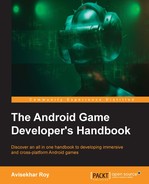Developers need to have experience of coding regular games for Android before they start building a VR experience with Cardboard. Here are a few areas that developers need to keep an eye on while developing VR games for Google Cardboard:
- Draw call limitations
- Triangle count limitations
- Keeping a steady FPS
- Overcoming overheating problems
- Aiming for a better audio experience
- Setting up proper project settings
- Using a proper test environment
VR games are obviously 3D games with an extensive rendering process. It is always a good practice to minimize the draw calls to limit the rendering time and reduce GPU overhead.
In general terms, based on the list of currently available devices, the developer should keep a rendering call limitation of 100 per frame. In the current industry, most of the developers are trying to keep the draw calls between 50 and 100.
We have already discussed the functionality of a vertex and triangle in 3D games. The same logic applies to VR games. However, it is more difficult to maintain performance in VR games than normal 3D games. That is why VR games usually use triangle counts within 100k.
Currently, the average triangle count of a decently performing VR game is around 50k to 80k. Developers need to simplify all of its 3D objects and optimize them in the minimum possible triangles and vertices to achieve a decent FPS at runtime.
For any Android game, keeping a steady and decent FPS is necessary. VR games for Android are not an exception. Through the above mentioned limitations, the developer can reduce rendering time to gain performance.
VR games work with a split-screen technology, which is a heavy process. So, the developer should decide and use the minimum possible game objects or elements to keep the FPS steady.
It is a big challenge for VR game developers to provide better visuals with limited resources. Designing and creating art assets is a major part. Using low-poly models with minimum triangles produces poor visual quality. However, this quality can be improved with the help of excellent texturing support for the model and strategic light mapping in the virtual reality world.
Overheating is a common problem for Android VR games. The device heats up while running a VR application due to the extensive use of CPU and GPU. There is not much a developer can do to overcome the problem completely. However, developers can optimize the VR game to reduce processor use. The game should have limited network use and other device components to minimize battery consumption.
Android VR games are played with the support of extra VR devices, such as Google Cardboard or similar. We have already discussed the devices in this chapter. Such devices do not have audio support; VR games use device speakers by default.
A virtual reality experience cannot be complete without proper audio experience. It is always good practice to use 3D environment audio in the game and suggest that users wear headsets while playing the VR game.
Setting VR project settings right early on can save the developer from headaches in the future. To get better project performance in particular, it is very important to set the quality settings properly at the beginning of the project. The entire project and performance planning cannot be fruitful without a prior project configuration.
Setting up your test environment is extremely important for the success of any game, especially for large-scale games such as VR. The developer must know the status of each development stage so that they can take future decisions to make the game better. In this way, the development process can run smoothly.
It is always recommended that you run the VR game for testing from outside the VR device. It is also recommended that you use the adb to check each debug condition and statement. It is very difficult to use a normal debug bridge for VR games as the game must be tested with a VR device. The developer needs to set up a wireless debug bridge to overcome this problem. The debug bridge can also be used to run and stop the game from outside the VR device. This way, the developer can save a lot of time, which can be used to improve the game.
